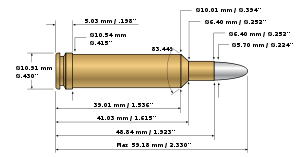.224 Weatherby Magnum
The .224 Weatherby Magnum (5.56×49mmB) is a sporting cartridge that was developed in 1963 by Roy Weatherby after about 10 years of development. It is a proprietary cartridge with no major firearms manufacturers chambering rifles for it other than Weatherby. It was originally called the .224 Weatherby Varmintmaster when it was introduced alongside the Weatherby Varmintmaster rifle, but the rifle was discontinued in 1994 and the cartridge was renamed.
| .224 Weatherby Magnum | ||||||||||||||||||||
|---|---|---|---|---|---|---|---|---|---|---|---|---|---|---|---|---|---|---|---|---|
| Type | Rifle | |||||||||||||||||||
| Place of origin | USA | |||||||||||||||||||
| Production history | ||||||||||||||||||||
| Designer | Roy Weatherby | |||||||||||||||||||
| Designed | 1963 | |||||||||||||||||||
| Specifications | ||||||||||||||||||||
| Parent case | None, proprietary | |||||||||||||||||||
| Case type | Belted, bottleneck | |||||||||||||||||||
| Bullet diameter | .224 in (5.7 mm) | |||||||||||||||||||
| Neck diameter | .252 in (6.4 mm) | |||||||||||||||||||
| Shoulder diameter | .394 in (10.0 mm) | |||||||||||||||||||
| Base diameter | .415 in (10.5 mm) | |||||||||||||||||||
| Rim diameter | .430 in (10.9 mm) | |||||||||||||||||||
| Case length | 1.923 in (48.8 mm) | |||||||||||||||||||
| Overall length | 2.330 in (59.2 mm) | |||||||||||||||||||
| Rifling twist | 1-12" | |||||||||||||||||||
| Primer type | Large rifle | |||||||||||||||||||
| Ballistic performance | ||||||||||||||||||||
| ||||||||||||||||||||
| Test barrel length: 24" Source(s): Hodgdon [1] | ||||||||||||||||||||

Design
The cartridge design began years earlier but its introduction was delayed, at least in part, because of the unavailability of a suitable action. An earlier high-velocity .22 caliber round from Weatherby called the .220 Weatherby Rocket was based on the .220 Swift though it was unsuccessful and never manufactured.[2]
Performance
Performance is similar to the popular .22-250 and the lesser used .225 Winchester putting it in between the .220 Swift and .223 Remington cartridges. Possibly because of the similar performance and popularity of the .22-250, this round has never gotten a very large following. Costs for ammunition and rifles for this round also tend to be much more expensive.
| Muzzle | 100 Yds | 200 Yds | 300 Yds | 400 Yds | 500 Yds | ||
|---|---|---|---|---|---|---|---|
| Trajectory | - | 2.8 | 3.7 | 0 | -9.8 | -27.9 | |
| Energy (ft·lbf) | 1627 | 1244 | 944 | 705 | 516 | 370 | |
| Velocity ([[Feet per second | ft/s]]) | 3650 | 3192 | 2780 | 2403 | 2056 | 1741 |
Sporting use
.22 caliber rifles are legal in some areas for big game up to the size of deer or larger. Convention holds the .224 Weatherby and similar cartridges are better suited to long-range varminting.[3] Similar statements are made concerning other "big" 22 caliber cartridges like the .220 Swift and .223 WSSM.
Currently many states in the United States do allow 22 caliber rifles on big game, but the majority require a minimum of 6mm.[4] Well known firearms author P.O. Ackley believed that fast 22 caliber cartridges were suitable for medium-large game.[5] Craig Boddington has said that such cartridges are suitable for smaller deer.[4] Bullets suited for hunting big-game are available from major manufacturers such as Nosler and Barnes.[6]
See also
- 5 mm caliber, other cartridges of 5–6 mm (.200–.236 in) caliber.
- List of rifle cartridges
- Table of handgun and rifle cartridges
References
- "Hodgdon Online Reloading Data". Archived from the original on 2007-11-16. Retrieved 2007-07-19.
- Cartridges of the World 8th Edition, Book by Frank C. Barnes, DBI Books, 1997, ISBN 0-87349-178-5 p. 23
- .224 Weatherby at Norma
- "Centerfire .22s For Big Game". Archived from the original on 2010-04-15. Retrieved 2010-06-29.
- Handbook for Shooters & Reloaders vol II, Book by P.O. Ackley; Plaza Publishing, 1966, ASIN B000BGII48
- "Nosler's Big-Game Bullets". Retrieved 2010-06-29.
